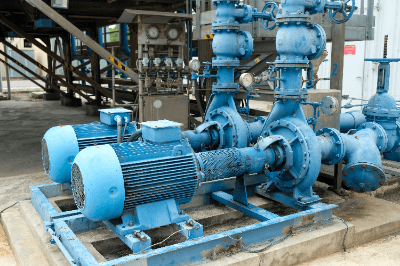What Is a Centrifugal Pump?
 A centrifugal pump is a type of pump that has an impeller-like impeller inside the pump casing. The casing has a volute shape and is also called a volute pump.
A centrifugal pump is a type of pump that has an impeller-like impeller inside the pump casing. The casing has a volute shape and is also called a volute pump.
Liquid enters the impeller through the suction port at the center, and is propelled outward at high speed by the centrifugal action of rotation. As it passes through the volute chamber, it is gradually decelerated and converted to pressure.
There are two types of centrifugal pumps: single-stage with one impeller and multi-stage with two or more impellers. The multistage type increases pressure with each stage and is used when high pressure is required.
Uses of Centrifugal Pumps
Centrifugal pumps are often used when a high flow rate and low pressure are required. They are widely used in industrial applications such as drainage, boiler water supply, water supply and sewage, mining, and chemical industry. They are also used in agriculture, such as for irrigation, and for water supply and drainage of air conditioning units.
Centrifugal pumps are often used for relatively low viscosity solutions with a solids volume concentration of 20% or less in the liquid. Those with improved vane shapes and materials to resist wear and corrosion are used for transporting muddy water, sewage, slurries, and pulp mixtures, sand and gravel, coal, and other liquids. Furthermore, by reducing the number of blades and increasing the flow path area, they can be used to transport fish, oranges, etc. along with water.
Principle of Centrifugal Pump
Centrifugal pumps use centrifugal force to impart pressure and velocity energy to a fluid by rotating an impeller in a casing. It is then decelerated in the volute-shaped casing and the velocity energy is converted to pressure energy. This phenomenon is known as Bernoulli’s theorem.
There are two types of impellers: a radial flow form with a two-dimensional curved surface in which the fluid flows in the radial direction, and a mixed flow form with a three-dimensional curved surface that changes from axial to radial in an incremental manner. This is an important element for efficiently converting velocity energy into pressure.
The casing is installed to form a spiral-shaped chamber outside the impeller. As the cross-sectional area gradually increases in the direction of rotation, the high-speed fluid ejected from the impeller by centrifugal force is gradually decelerated and the pressure (static pressure) increases.
There is a limit to the pressure that can be generated by a single impeller. If higher pressure is required, a multi-stage pump is used. In a multi-stage pump, the fluid leaving the first impeller is sucked into the second impeller to further increase pressure. This can be repeated several times to obtain high pressure.
Pump Structure
Pump construction is closely related to flow rate and head, and is an important selection criterion when choosing a pump. Centrifugal Pumps consist of an impeller and volute casing, shaft, bearings, drive coupling, and suction and discharge couplings, shaft sealing device, and if necessary, a pressure gauge, pressure sensor, and pressure switch.
There are pumps with non-rotating fixed guide vanes arranged around the periphery of the impeller. They are called diffuser pumps or turbine pumps and are part of the centrifugal pump family. The mechanism is similar to that of centrifugal pumps, but the fluid leaving the impeller is efficiently decelerated as it passes through the guide vane and the static pressure increases, resulting in higher overall efficiency.
Other Information on Centrifugal Pumps
Centrifugal Pumps and Cavitation
Since the pump structure is designed to convert liquid to pressure, problems can occur if gases are introduced into the pump or if gases are generated inside the pump. One of these problems is cavitation.
Cavitation in pumps is a phenomenon in which the pressure of a liquid drops rapidly inside the pump, and when it reaches saturation vapor pressure, the liquid vaporizes rapidly. Cavitation in centrifugal pumps occurs when the static pressure of the fluid decreases due to the increased velocity of the liquid flowing into the impeller and the static pressure near the inlet falls below the saturation vapor pressure of the fluid.
Repeated cavitation causes damage to the impeller, resulting in cavitation erosion. Vibration and noise are also generated, and performance is reduced. This leads to premature deterioration and destruction of the equipment, not only in the centrifugal pump but also in the pipes and valves.
Cavitation can be prevented by changing operating conditions, reducing resistance on the suction side, and improving the shape and area of the impeller so that the fluid pressure does not fall below the saturated vapor pressure.